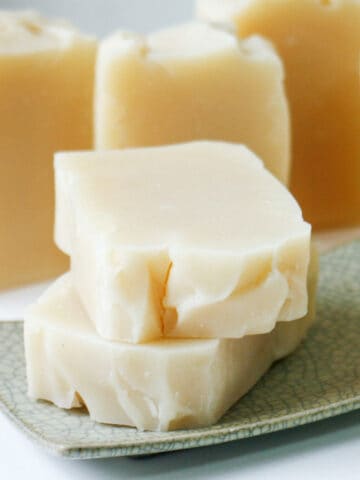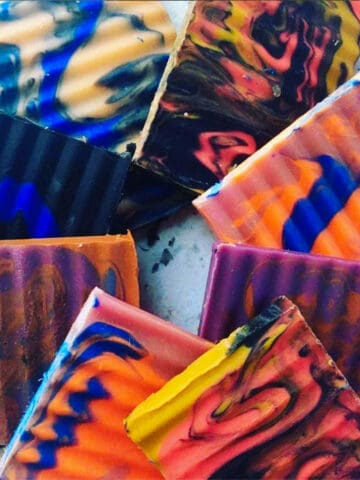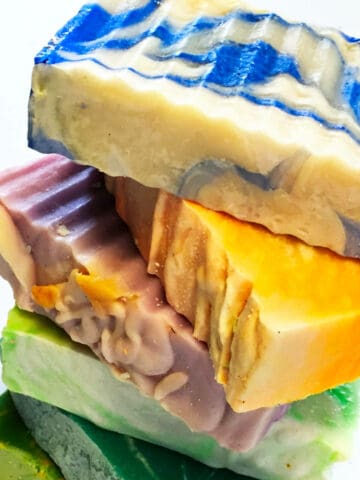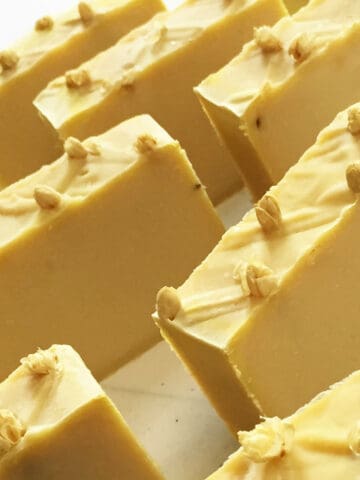https://www.soapalooza.com/blog/superfatting-what-is-it/
Blackberry Apple Cold Process Soap
/
/
/
/First to simplify, “super fatting” is the purposeful unbalancing of a chemical equation or mole. You normally would balance the lye solution (alkali) to equally match the acids in the oils you are using to a perfect 1:1 chemical mole balance. That would give you excellent laundry soap, but would not be very emollient to your skin.
/
/
/
/The object of ‘super fatting’ is to have your formulation of lye solution and oils set up to be oil heavy, meaning that there will be more oil molecules than lye molecules and the match up of covalent bonding will leave excess unused oil molecules free in your soap mixture/soap bars. This is where you get the extra emollient properties of your soap, or some… as the glycerin is a contributor too. So essentially, ‘super fatting’ is just making sure you leave a little extra oil free in your soap.
/
/
/
/There are two ways to do this. Either one is absolutely fine, or if you set your calculations up right you can even do both together. It is a purely personal choice on HOW you decide to super fat, just be sure and use a good calculator when formulating so you can be precise.
/
/
/
/Method 1: Effective Lye Discount/Ratio (referred as either on some calculators, ELD or ELR)
/
/This is where you do not add extra oils at trace to create your “super fat’ effect. You build in an automatic ELR when you set up your formulation in your calculator to create the lye discount you want… 5%, 6%, 7% are the most common values. Setting your calculator to leave 5% is superfat built into the formulation. Lower than 5% without adding additional fats/oils at trace can contribute to a harsher bar, and super fatting over 10% can lend toward the loose oils going rancid faster in time. I recommend 6% – 7% to start with. Superfatting at 0% is a perfect balance of oils and lye (acid & alkali), however it is generally too harsh of soap for the body.
/
/
/
/Most calculators allow you to adjust the lye discount/effective lye ratio figure. You plug all your oils in the calculator to be mixed with the lye in the beginning. The only value that changes the super fat/ELR value is the AMOUNT OF LYE USED. Less lye means the ELR super fatting increases to larger numbers (i.e., reducing lye by 1 oz may cause the ELR super fatting to go up from 6% to 7%). Increasing lye value lowers the ELR super fatting (i.e., increasing lye by 1 oz may cause the ELR super fat to go from 6% to 5%). You can manually adjust this by changing the lye value in your calculator until you have the % of super fat/ELR that you want your bar to have.
/
/
/
/Method 2: Super fatting at Trace
/
/This way you build your formulation up with a small amount (2-5% of total oils used) to be added at the mid to end of trace time. You set your formulation up with a much lower Effective Lye Ratio, often at zero.
/
/
/
/After you calculate the lye needed for your main base oils, you then input extra oils to the calculator that are to be added separately at trace. Adjust that super fat oil amount until you arrive at the super fat/ELR value you want your bar to end up at. Using this way of super fatting though, you will use more lye in your formulating. The hypothesis to superfatting at trace is that you have more control of which oils actually create the final superfat effect that is residual in the final bar (more on this at the end). For instance, if you make a bar of soap using coconut, palm, and olive as the soap recipe, but add Hempseed oil at trace, the first three oils will have used up most lye by the time you add the Hempseed as the superfat oil. The hypothesis is that less Hempseed oil will be tied up by the remaining lye, leaving more Hempseed free than the other oils.
/
/
/
/If you don’t start at zero superfat for this method you will have an extremely high superfat when you also add extra oils at the trace. High superfat bars can go rancid, developing off odor and sometimes brownish orange spots referred to as DOS, or Dreaded Orange Spots.
/
/
/
/Showing how superfat at trace consumes more lye:
/
/Follow along with this example of a four-oil recipe (and feel free to use it as a starter recipe):
/
/
/
/All amounts are digital weights, not volume.
/
/
/
/10 oz Olive Oil
/
/10 oz Coconut Oil
/
/10 oz Shortening
/
/2 oz Sweet Almond Oil
/
/11 oz Water
/
/4.5 oz lye
/
/
/
/Now here is what happens to the lye when you add the almond oil with the others (as in Method 1), and what happens when you add it at the end of trace:
/
/
/
/Method 1: 4.5 oz Lye gives a 6% lye ratio/discount in the calculator and in the final bar a 7.6% effective Lye Ratio, or super fat.
/
/
/
/But if I do not add that 2 oz of Sweet Almond oil until the end of trace (as in Method 2) look what happens:
/
/
/
/Method 2: 4.5 oz lye gives a 6% lye discount and in the final bar (with Sweet Almond added at END OF TRACE, not with rest of oils) an 11.7% Effective Lye Ratio, or SUPER super fat! 11.7 is terribly high. Many oils we use for superfatting have shorter shelf lives and by merit of that can go rancid much faster. To pull the Effective Lye Ratio DOWN a bit, so that the bar is not at 11.7% I must INCREASE my lye value on the calculator, or reduce those trace time superfatting oils to a smaller amount! I must use 4.6 oz of lye instead of 4.5 oz to get that 6% super fat ratio!
/
/
/
/The reason why the super fat oils added at trace create a higher superfat value and/or cause more lye to be used in the formulation, is because when you mix your oils & lye solution first, then add trace oils last, much of your lye solution has already been saponified with the main pot of oils! That means there is less active lye to bind up with oil added at trace super fat oils.
/
/
/
/Now the Million Dollar Question… Can you Control or Manipulate which oils will be the SuperFat oils?
/
/
/
/Ok… taking the concept from the previous example of Method 2, adding selected supefat oils at trace, one sees that larger amounts of the superfat oils are left remaining available, free, loose in the bar to affect the skin. The superfat % is actually higher when the same exact amount of total oils are used to make soap, when the superfat oils are added at trace rather than upfront with the main base oils in the form of lye discount. Since these oils are added at trace, and less of them bound up by lye solution, it is hypothesised that those are the unused oils that remain in the bar to create the superfat effect for the skin.
/
/
/
/Because we can see that there is a higher percentage of unsaponified oils available in the soap when superfatting is conducted at trace, superfatting at trace allows possible control over which oil properties are the effective superfatting oils. If one adds Jojoba oil at trace instead of adding to the main base oils and taking a lye discount, the hypothesis is that there will be more free Jojoba molecules free in the final bar with the trace superfatting method than with the lye discount method.
/
/
/
/The #1 disadvantage to adding oils as superfat at trace though is that it is very easy to forget to add them, leaving you with a batch of soap that is lye heavy, or just harsher than you intended. It is very easy to get distracted and to forget to add those last few ounces of superfat oil when entranced watching soap trace!





Leave a Reply